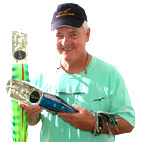| HOOK CHOICES, DISSECTING THE MYTH
I am amazed at the variety of hook rigs I see in the many different fishing
ports around the world that I visit. I am equally amazed at what is sold to
fishermen as hook rigs pre-made. That being said, let’s get on with my
job in this article of trying to untangle some of this confusion and myth. Hopefully,
some of the information supplied will simplify your hook rigs and get you off
to a great start.
When using the Mustad #7731 forged steel or the #7732 stainless hook. This
style of hook has an open shank suited best for rigging live or dead bait. The
gap is open and ready to grab meat. Good choice if you are fishing bait. Bad
choice if you are trolling lures. A better choice would be the 7690 tinned or
the 7691 Stainless. This type of hook is often referred to as a Tuna Bend.
The dynamics of the Tuna Bend is more suitable for trolling lures.
The point is not open and reaching for meat ... quite the opposite occurs. Once
the fish strikes your lure and gets anywhere near this hook, it turns in similar,
but not like a circle hook, and grabs. In other words, the point turns in and
down, rather than open, reaching for meat. You will notice a marked improvement
in your lure fishing success while using the Tuna Bend type of hook
when lure fishing.
My thoughts on different styles of hook rigs falls into the K.I.S.S.
or Keep it Simple Stupid school of thought. When tolling lures I strictly
use the single hook stiff cable rig with the tip of the barb protruding just
outside of the skirt area, but not far enough that the eye of the hook is outside
of the skirt (illegal for IGFA use).
Single Hook Stiff Rig Advantages
· Artificial lures troll better when using single hook, more bites,
solid hook ups, and less pulled hooks.
· Line chafing after hook-up, and especially when fighting big fish
for a lengthy term is less threatening.
· Safety factor is greatly improved for the crew and wireman; releasing
fish is easier & faster. The IGFA is presently considering a no option single
hook only, rule.
· No foul hooks with in the skirts of lure due to the tip of the hook
being outside the skirt area.
· 50% larger target area when trying to hook marlin from the outside
of the mouth in, rather than the inside out.
· Use lures that have a Hook Lock™ that will keep your
hook rig locked into the best position for hook up at all times vs. letting
the hook rig turn and rotate around inside the lure while you troll. This reduces
the effect of the lures design and action.
A few thoughts on the other varieties of lure hook rigs in use
· Double hook rigs, both hooks pointing in same direction up. (Good)
· 180 degree rigs, one hook up one down. (Good)
· Single hook rig, mono connection. (Very Bad) Chafe
· 90 degree hook rigs, a.k.a. St. Thomas stiff rig. (Garbage) Due to
the effects of the extra weight being off center of the lure causing the lure
swim irregularly and even worse causing it to spin. Not good for hook-ups.
How to sharpen a hook
My choice would be to leave the underside of hook alone and sharpen the top
of hook point on both sides, filing from the barb to the tip, on both sides.
There is a round file made that connects two files together that will make that
top cut perfect. You simply line-up the point inside of the two round files
and stroke away. You should also decrease some of the barb. Too much barb is
a hindrance, making it difficult to poke through a densely structured mouth.
A bit of the point should be chopped off and then made sharp but not fragile.
These big fish are not trout, they are trucks.
Going the full mile, after you have completed the task of getting your hooks
sharp, sand them with wet and dry sandpaper taking off any rough surfaces. Then
put them on a buffing pad with polishing compound until the tips are like a
mirror. All of this work and preparation should be completed before the fishing
season ever starts.
You won’t find hooks like I have just described ready-made and ready
to fish. I should have stated that it is more difficult to find the perfect
hook ready to fish. There is one called the Gamakatsu Blade Point Tuna Hook.
You can fish it right out of the box, it has a needle eye, and thus this hook
should have a stainless steel leader connection. You must slide a fine piece
of chafe tubing over your S.S. Leader for insulation against dissimilar metals
being in contact with each other. The tin plating finish on this strong steel
hook will last longer if insulation is intact. Also, try a quick spray of corrosion
block over your hooks at the end of the day’s fishing. Felt marking pen
ink can also be used. Corrosion will be kept minimal if these preparations are
performed. If you choose to run your mono leader through the eye of hook, then
please use chafe tubing over the top of your leader. Remember, when crimping
stainless steel leader materials use brass or zinc sleeves rather than aluminum.
Aloha, great fishing!

Captain Bart Miller
captbartmiller@blackbartlures.com
(561) 842-4550 or (866) 289-7050
Back
to The Cockpit
|